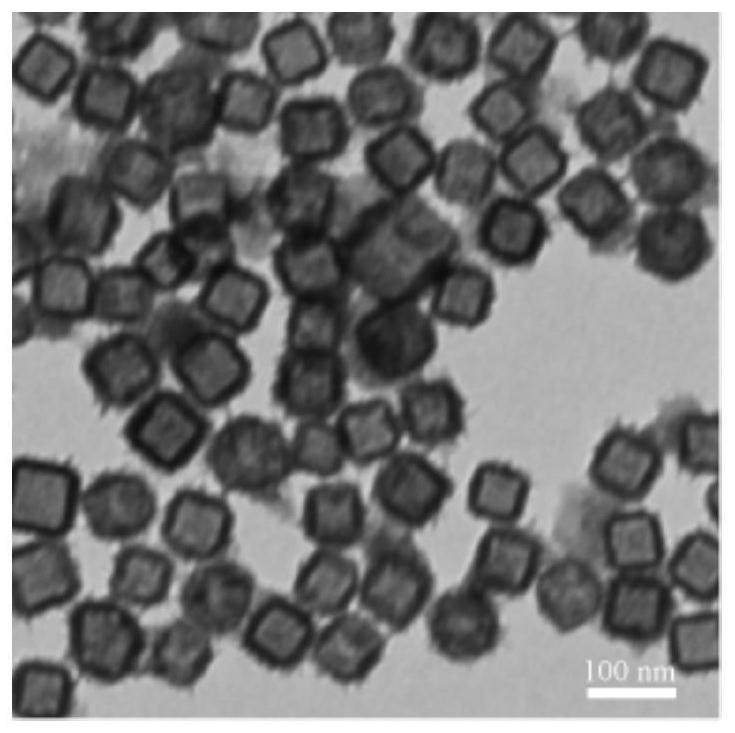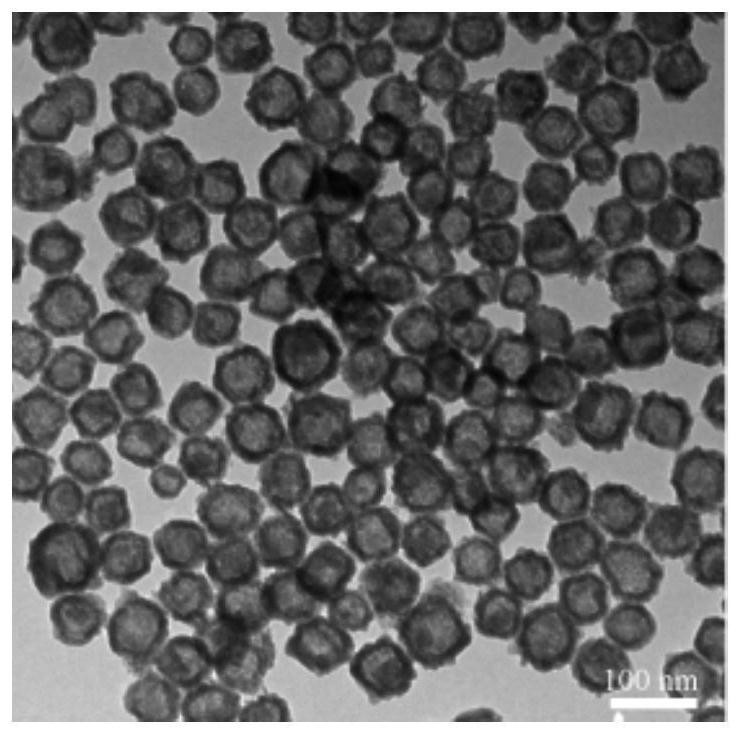Hollow Cu7S4 nano cubic structure and preparation method and application thereof
A nano-cubic and cubic-structure technology, applied in nanotechnology, nanotechnology, nanomedicine, etc., can solve the problems of low photothermal conversion efficiency, low biological toxicity, cytotoxicity, etc., and achieve high photothermal conversion efficiency and simple preparation method , good biocompatibility
- Summary
- Abstract
- Description
- Claims
- Application Information
AI Technical Summary
Problems solved by technology
Method used
Image
Examples
Embodiment 1
[0047] Weigh 4g of polyvinylpyrrolidone (PVP) with a molecular weight of 10000 at room temperature of 25°C, dissolve it in 400mL of deionized water and stir. After magnetically stirring for 10 minutes, add 3.5mL of 0.1mol / L copper acetate solution and continue stirring. After 5min, add 3.6mL of 1mol / L copper acetate solution. L sodium hydroxide solution, adjust the pH of the solution to about 11.0, add 6 mL of 0.1mol / L ascorbic acid solution after 30 seconds, and continue stirring for 30 minutes. Then heat the oil bath to 92 ° C, add 2 mL of 0.1 mol / L sodium sulfide solution under stirring for 2 h, and after the reaction is complete, centrifuge the product for 15 min to remove the lower layer of precipitate and wash, repeat the above steps 3 times, and disperse into deionized water ( 100μg / mL), that is, hollow Cu 7 S 4 Nano-cubic structure, the side length of the cube is about 70-80nm, such as figure 1 shown. figure 2 For the obtained hollow Cu 7 S 4 UV-Vis map of the na...
Embodiment 2
[0049] Weigh 5 g of polyvinylpyrrolidone (PVP) with a molecular weight of 10,000 at room temperature at 25°C, dissolve it in 400 mL of deionized water and stir. After magnetically stirring for 10 min, add 3.5 mL of 0.1 mol / L copper acetate solution and continue stirring. After 6 min, add 4.5 mL of 1 mol / L copper acetate solution. L sodium hydroxide solution, adjust the pH of the solution to about 11.0, add 6 mL of 0.1 mol / L ascorbic acid solution after 30 seconds, and continue stirring for 40 minutes. Then heat the oil bath to 95 ° C, add 2 mL of 0.1 mol / L sodium sulfide solution under stirring for 2 h, and after the reaction is complete, centrifuge the product for 15 min to remove the lower layer of precipitate and wash, repeat the above steps 3 times, and disperse into deionized water ( 100μg / mL), that is, hollow Cu 7 S 4 nanocubic structure.
Embodiment 3
[0051] Weigh 5 g of polyvinylpyrrolidone (PVP) with a molecular weight of 24,000 at room temperature at 25°C, dissolve it in 400 mL of deionized water and stir. After magnetically stirring for 10 minutes, add 3.5 mL of 0.1 mol / L copper acetate solution and continue stirring. After 5 minutes, add 3.6 mL of 1 mol / L copper acetate solution. L sodium hydroxide solution, adjust the pH of the solution to about 11.0, add 6 mL of 0.1 mol / L ascorbic acid solution after 30 seconds, and continue stirring for 40 minutes. Then heat the oil bath to 90°C, add 2mL of 0.1mol / L sodium sulfide solution to react for 1.5h under stirring, after the reaction is complete, centrifuge the product for 15min to remove the lower layer of precipitate and wash, repeat the above steps 3 times, and disperse into deionized water (100μg / mL), that is, hollow Cu 7 S 4 nanocubic structure.
PUM
 Login to View More
Login to View More Abstract
Description
Claims
Application Information
 Login to View More
Login to View More - R&D Engineer
- R&D Manager
- IP Professional
- Industry Leading Data Capabilities
- Powerful AI technology
- Patent DNA Extraction
Browse by: Latest US Patents, China's latest patents, Technical Efficacy Thesaurus, Application Domain, Technology Topic, Popular Technical Reports.
© 2024 PatSnap. All rights reserved.Legal|Privacy policy|Modern Slavery Act Transparency Statement|Sitemap|About US| Contact US: help@patsnap.com










